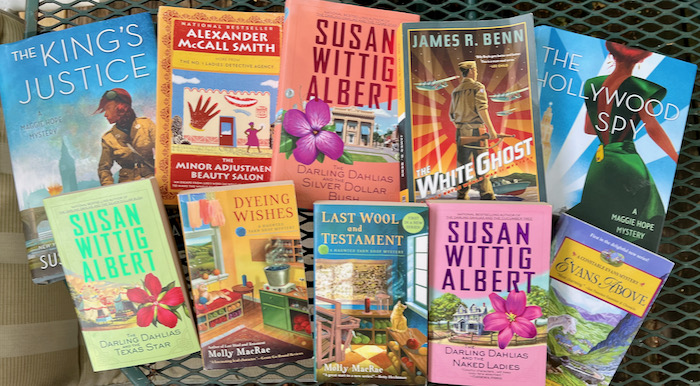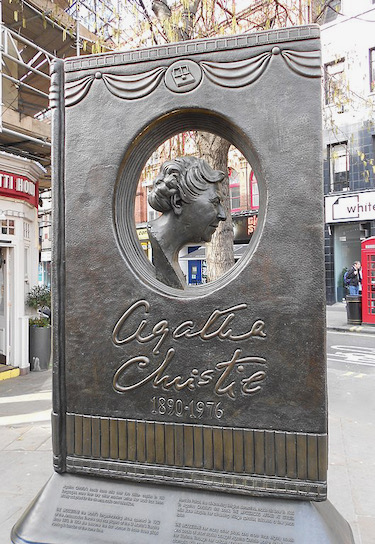What is a cozy mystery? And how can I write a cozy mystery?

Edgar Allen Poe. Arthur Conan Doyle. Agatha Christie. Carolyn Keene. Sue Grafton. Jacqueline Winspear. Susan Wittig Albert. Janet Evanovich.
And—You.
Yes, You could join that list. That’s especially true if you already enjoy reading cozy mystery novels or watching the dozens of cozy TV series—especially the abundance of made-for-TV series broadcast via Hallmark, PBS, BBC and Acorn. With a little planning and coaching, you could spin your own cozy tale of an intrepid sleuth, perhaps an amateur just like you, tracking down the evildoer who has disrupted your otherwise charming community.

I have been making this basic pitch to authors and journalists for decades, because my wife and I are lifelong cozy fans and I am eager to see more of these tales popping up in an ever-wider, ever-more-colorful range of settings.
The “world” of cozies is both infamously intimate and as vast as our planet. Agatha Christie was a pioneer in taking her cozy fans to colorful locations around the world. Countless authors in this genre followed her. For example, how many of us have enjoyed the vivid African scenes spun by Alexander McCall Smith? Rita Mae Brown made room for our beloved pets in her mysteries! Katherine Hall Page gives us regional recipes to enjoy along the way toward solving the crime. There are now LGBTQ mystery series, Black cozies, Asian series, cozies set in church choirs, mysteries that include knitting patterns, crossword puzzle cozies—on and on. There are even Amish armchair sleuths!
Why bother with this challenge I am posing?
It’s fun.
Millions of cozy mysteries sell each year.
Cozy writers often get to know their loyal fans.
These novels are relatively short, so the authors tend to produce at least one a year, sometimes more.
What’s not to like about this genre?
Well, the fact is, even veteran journalists and authors—who could choose to become master cozy writers—are daunted by sitting down to plan and write an entire mystery novel.
That’s why our publishing house was thrilled, recently, to prioritize publishing our own first cozy mystery sometime in 2023. Stay tuned for details, which we’re just discussing with potential authors!
So, what is a cozy mystery?
Many definitions are floating around online. Basically, “cozy” refers to mysteries that are solved in a well-defined “community” making the scenes in these tales feel, well, “cozy.” The community might be as tiny as a dinner party or as intimate as a small town or it might involve the passengers on a train or cruise ship. Some definitions of the genre focus on the fact that cozies tend to feature either amateur sleuths or private investigators, contrasting that with mystery genres that follow police or FBI “procedurals.” Cozies are suspenseful. However, they generally are less gory, less horrifying and more entertaining—even downright funny on occasion. Fans of Stephanie Plum, created by mystery writer Janet Evanovich, have found themselves laughing aloud at unexpected moments in Stephanie’s over-the-top adventures.
Other leading definitions:
Wikipedia says: Cozy mysteries, also referred to as cozies, are a sub-genre of crime fiction in which sex and violence occur off stage, the detective is an amateur sleuth, and the crime and detection take place in a small, socially intimate community. Cozies thus stand in contrast to hardboiled fiction, in which more violence and explicit sexuality are central to the plot.
Cozy author Amanda Flower says: The cozy lesson is an average person can make a difference. It doesn’t matter if the protagonist is a knitter, a librarian, or a gardener—that person can solve a murder. The hero archetype of the average person rising to the challenge in extraordinary circumstances has been a theme in literature since ancient times. Think David and Goliath. It comes as no surprise that the theme remains popular.
Cozy author Louise Penny says: My books aren’t about murder—that’s simply a catalyst to look at human nature. They aren’t about blood but about the marrow, about what happens deep inside, in places we didn’t even know existed.
Cozy author Oliva Blacke writes: A new generation of cozies are appealing to a new audience. Abby Collette’s Ice Cream Parlor Mysteries, Mia P. Manansala’s Tita Rosie’s Kitchen Mysteries, and my own Brooklyn Murder Mysteries all feature Millennial main characters. Whereas traditionally, cozy heroines were often middle aged women, like Agatha Christie’s spinster busybody Miss Marple or Murder She Wrote’s Jessica Fletcher, these recent books trend younger. Manansala’s Lila Macapagal in Arsenic and Adobo, Collette’s Bronwyn Crewse in A Game of Cones, and Odessa Dean in my cozy mystery debut, Killer Content, are all amateur sleuths in their early twenties, and all are characters that feel like they’d be fun to sit down and have a beer with when they’re not solving crimes.
Care to read more about cozy mysteries?
- Search the cozy authors’ names listed above in Amazon.
- One of the world’s most popular cozy-fan sites certainly doesn’t look like much—but it packs a vast overview of the genre. In keeping with the genre itself, it’s definitely an “amateur” site, called simply Cozy Mystery List.
- Wikipedia claims there are at least nine sub-genres within “mystery.” So, this big Wiki page helps to sketch in the many options for plotting a fictional crime beyond the basic cozy.
- Acorn TV brings American viewers some of the world’s best made-for-TV cozy series featuring top sleuths from as far away as Australia and New Zealand. Acorn and Hallmark, below, are an easy way to immerse yourself in the genre’s global potential.
- Hallmark Mysteries channel also has transformed dozens of cozies into made-for-TV movies and movie series.
How do I start writing a cozy mystery?
Here are some tips shared by many veteran cozy authors and editors in magazines and publishing conferences:
You’ll care! That’s the first promise we make to readers in this genre—so, our main characters should be likable. That’s especially true since nearly every successful cozy writer thinks of their ongoing work in terms of a “series” rather than stand-alone novels. We want our readers to fall in love with our characters (and their quirks and their friends)—so that our readers will seek us out online and sign up for email updates about our subsequent novels.
The villain’s hiding in plain sight. Introduce enough characters so that, in the end, your evildoer is someone already known to readers. Sketching a variety of personalities within your plot is key to the “cozy” promise that this puzzle can be solved within the little world that’s described by the author. Readers are likely to feel cheated if the solution in the final 10 pages involves suddenly dragging some unknown rogue onto the stage to shoulder the blame.
Write what you know. For a first-time writer, consider making your main character and basic setting as close to your world as possible. While it’s true that some successful cozy writers explore earlier historical eras and far-away places—successful authors know that their novels are most compelling when describing realms they thoroughly understand. Yes, Agatha Christie from her home in the UK famously wrote Death on the Nile—but many details and entire scenes were based on her own experience of upper-class British tourism in Egypt. Whatever your life situation, first consider how someone just like you might stumble across a crime and help to nab the perpetrator. You may be surprised by how “big” your own “little” world can become!
You’ve got to love it. Choose characters and a basic plot that are so exciting to you that you wake up each morning eager to continue writing. If you find yourself deep in writer’s block, the simplest solution is to stop and consider recasting and reconfiguring your tale so you look forward to “meeting” these folks again each morning. That “waking up eager to write” test is a remarkably accurate compass for a compelling plot.
Enough is enough. Don’t tackle too much. Editors often say that a novel is “a world between two covers,” but you don’t have to cover the entire world in your first novel. If you find your imagination spinning way too many sub-plots, reserve some of those tales for your future volumes. A typical first cozy is 50,000 to 60,000 words, although there are many exceptions to that rule.
Be kind to our furry friends! Animal cruelty is a dangerous plot twist. Die-hard cozy fans also are famously animal-friendly readers. Many cozy editors tell their writers flat out: Don’t harm any animals in the course of your first novel. If you do harm an animal, you’d better have a good reason for taking that risk.
Don’t cheat our readers. Cozy authors don’t always allow their readers to solve their puzzles, before the final pages, but they do play a fair game overall. Agatha Christie was infamous for pushing this rule to the limit. For example, she would withhold key details until the “big reveal” at the end of her novels, so readers could never hope to out-pace her sleuths. She got away with that for many years. But generally, the most avid cozy readers want their mysteries to make sense and even to feel that they’ve got a good amateur’s guess at where the plot might be heading.
Interested in writing a cozy mystery?
Please, contact us!